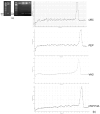Selection of Reference Genes and HSP17.9A Expression Profiling in Heat-Stressed Grapevine Varieties
- PMID: 39457407
- PMCID: PMC11507026
- DOI: 10.3390/genes15101283
Selection of Reference Genes and HSP17.9A Expression Profiling in Heat-Stressed Grapevine Varieties
Abstract
Background: "Touriga Franca" (TF) and "Touriga Nacional" (TN) are grapevine varieties cultivated in the 'Douro Superior' subregion (Northern Portugal) that experience stressful environmental conditions during the summer.
Objectives: Aiming to profile the expression of stress-responsive genes by quantitative real-time PCR (qPCR) in TF and TN plants growing naturally, three candidate reference genes were first tested under controlled conditions.
Methods: To simulate a summer's day, TF and TN in vitro plants were exposed to 32 °C-3 h (heat acclimation) and 42 °C-1 h (severe heat stress, HS) followed by two recovery periods (32 °C-3 h and 24 °C-24 h). Leaf samples were collected at the end of each phase. Control plants were kept at 24 °C.
Results: Among the candidate reference genes, the UBC and VAG pair showed the highest stability. The suitability of these genes for qPCR was validated by heat shock protein 17.9A (HSP17.9A) gene profiling. The HSP17.9A expression was up-regulated in both varieties and all experimental phases except in TF control plants. TN showed the highest HSP17.9A relative expression ratio after severe HS.
Conclusions: TN responded faster than TF to the induced heat shocks. The UBC, VAG, and HSP17.9A genes revealed to be suitable for further qPCR assays in TF and TN grapevine varieties.
Keywords: Ubiquitin-conjugating enzyme (UBC) gene; Vacuolar ATPase subunit G (VAG) gene; gene expression; heat shock protein; in vitro culture; quantitative real-time PCR (qPCR).
Conflict of interest statement
The authors declare no conflicts of interest.
Figures


References
-
- Jones G.V., White M.A., Cooper O.R., Storchmann K. Climate change and global wine quality. Clim. Change. 2005;73:319–343. doi: 10.1007/s10584-005-4704-2. - DOI
-
- Fraga H., Santos J.A., Malheiro A.C., Oliveira A.A., Moutinho-Pereira J., Jones G.V. Climatic suitability of Portuguese grapevine varieties and climate change adaptation. Int. J. Clim. 2015;36:1–12. doi: 10.1002/joc.4325. - DOI
MeSH terms
Substances
Grants and funding
- BPD/UTAD/INNOVINE&WINE/593/2016/Portugal 2020 under the project INNOVINE&WINE - Vineyard and Wine Innovation Platform (NORTE-01-0145-FEDER-000038, research line Viticulture
- UIDB/04033/2020 (https://doi.org/10.54499/UIDB/04033/2020)/Fundação para a Ciência e a Tecnologia
- DL 57/2016/CP1378/CT0003 (doi:10.54499/DL57/2016/CP1378/CT0003)/Fundação para a Ciência e a Tecnologia
LinkOut - more resources
Full Text Sources
Miscellaneous

